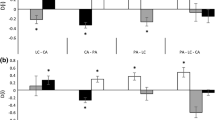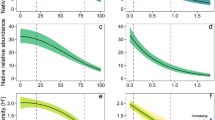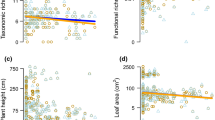Abstract
Exotic species can cause changes to their invaded ecosystems, which can be large and long lasting. Despite most landscapes being invaded by multiple exotic plant species, >90 % of impact studies only characterize the impacts of single species. Therefore, our knowledge of invasive plant impacts does not reflect the co-invaded nature of most landscapes, potentially ignoring complex interactions among exotic species. Our objective was to characterize potential invader synergies (positive interactions) on biotic and abiotic ecological parameters among the important forest invaders Japanese stiltgrass (Microstegium vimineum) and wavyleaf basketgrass (Oplismenus undulatifolius), which co-invade eastern US deciduous forests. To characterize synergies, we used a factorial selective removal study, as well as an observational study to further explore invader cover-impact relationships. Although both invaders can reduce native plant richness by 70 % individually or in combination, there were no impact synergies. Total cover of any combination of the two invaders had a negative quadratic effect on total, exotic, and native plant richness; i.e., all community metrics were greatest at intermediate levels of total invader cover and lowest at maximum invader cover. Native richness was more greatly affected than exotic richness by the co-invasion. Soil metrics had no clear trend in either study. Japanese stiltgrass and wavyleaf basketgrass appear to have overlapping impact niches—the number, magnitude, and direction of biotic and abiotic changes to the invaded ecosystem—that only vary in impact magnitude, not breadth. As a result of their overlapping impact niches and non-synergies in this co-invaded system, the addition of the recent invader wavyleaf basketgrass has not resulted in additional changes to the invaded forests. Future impact studies should focus on multiple species and identifying synergies, especially as they relate to invader cover, which informs ecological interactions and management prioritization.






Similar content being viewed by others
References
Alvarez ME, Cushman JH (2002) Community-level consequences of a plant invasion: effects on three habitats in coastal California. Ecol Appl 12:1434–1444. doi:10.2307/3099982
Baiser B, Lockwood JL, Puma D, Aronson MFJ (2008) A perfect storm: two ecosystem engineers interact to degrade deciduous forests of New Jersey. Biol Invasions 10:785–795. doi:10.1007/s10530-008-9247-9
Barney JN, Tekiela DR, Dollete ES, Tomasek BJ (2013) What is the “real” impact of invasive plant species? Front Ecol Environ 11:322–329. doi:10.1890/120120
Barney JN, Tekiela DR, Barrios-Garcia MN et al (2015) Global Invader Impact Network (GIIN): toward standardized evaluation of the ecological impacts of invasive plants. Ecol Evol 5:2878–2889. doi:10.1002/ece3.1551
Beauchamp V, Koontz S, Suss C et al (2013) An introduction to Oplismenus undulatifolius (Ard.) Roem. & Schult. (wavyleaf basketgrass), a recent invader in Mid-Atlantic forest understories 1, 2. J Torrey Bot Soc 140:391–413. doi:10.3159/TORREY-D-13-00033.1
Blackburn TM, Essl F, Evans T et al (2014) A unified classification of alien species based on the magnitude of their environmental impacts. PLoS Biol. doi:10.1371/journal.pbio.1001850
Brewer JS (2011) Per capita community-level effects of an invasive grass, Microstegium vimineum, on vegetation in mesic forests in northern Mississippi (USA). Biol Invasions 13:701–715. doi:10.1007/s10530-010-9861-1
Collins SL, Glenn SM, Gibson DJ (1995) Experimental analysis of intermediate disturbance and initial floristic composition: decoupling cause and effect. Ecology 76:486–492. doi:10.2307/1941207
Cushman JH, Gaffney KA (2010) Community-level consequences of invasion: impacts of exotic clonal plants on riparian vegetation. Biol Invasions 12:2765–2776. doi:10.1007/s10530-009-9682-2
DeMeester JE, Richter DdeB (2010) Differences in wetland nitrogen cycling between the invasive grass Microstegium vimineum and a diverse plant community. Ecol Appl 20:609–619. doi:10.1890/09-0283.1
Didham RK, Tylianakis JM, Hutchison MA et al (2005) Are invasive species the drivers of ecological change? Trends Ecol Evol 20:471–474. doi:10.1016/j.tree.2005.07.006
Ehrenfeld JG (2010) Ecosystem consequences of biological invasions. Annu Rev Ecol Evol Syst 41:59–80. doi:10.1146/annurev-ecolsys-102209-144650
Fairbrothers D, Gray J (1972) Microstegium vimineum (Trin.) A. Camus (Gramineae) in the United States. Bull Torrey Bot Club 99:97–100
Flory SL, Clay K (2009) Non-native grass invasion alters native plant composition in experimental communities. Biol Invasions 12:1285–1294. doi:10.1007/s10530-009-9546-9
Gooden B, French K, Turner PJ, Downey PO (2009) Impact threshold for an alien plant invader, Lantana camara L., on native plant communities. Biol Conserv 142:2631–2641. doi:10.1016/j.biocon.2009.06.012
Greene BT, Blossey B (2011) Lost in the weeds: Ligustrum sinense reduces native plant growth and survival. Biol Invasions 14:139–150. doi:10.1007/s10530-011-9990-1
Hellmann JJ, Byers JE, Bierwagen BG, Dukes JS (2008) Five potential consequences of climate change for invasive species. Conserv Biol 22:534–543. doi:10.1111/j.1523-1739.2008.00951.x
Isermann M (2007) Effects of the expansion by Hippophaë rhamnoides on plant species richness in coastal dunes. Appl Veg Sci 10:33–42. doi:10.1658/1402-2001(2007)10[33:EOTEBH]2.0.CO;2
Jeschke JM, Bacher S, Blackburn TM et al (2014) Defining the impact of non-native species. Conserv Biol 00:1–7. doi:10.1111/cobi.12299
Kourtev P, Huang W, Ehrenfeld J (1999) Differences in earthworm densities and nitrogen dynamics in soils under exotic and native plant species. Biol Invasions 1:237–245. doi:10.1023/A:1010048909563
Kourtev P, Ehrenfeld J, Häggblom M (2003) Experimental analysis of the effect of exotic and native plant species on the structure and function of soil microbial communities. Soil Biol Biochem 35:895–905. doi:10.1016/S0038-0717(03)00120-2
Kuebbing SE, Nuñez MA, Simberloff D (2013) Current mismatch between research and conservation efforts: the need to study co-occurring invasive plant species. Biol Conserv 160:121–129. doi:10.1016/j.biocon.2013.01.009
Kumschick S, Gaertner M, Vila M et al (2015) Ecological impacts of alien species: quantification, scope, caveats, and recommendations. Bioscience 65:55–63. doi:10.1093/biosci/biu193
Kuppinger D (2000) Management of plant invasions in the southern Appalachians. Chiquapin 8:21
Litt AR, Cord EE, Fulbright TE, Schuster GL (2014) Effects of invasive plants on arthropods. Conserv Biol 00:1–18. doi:10.1111/cobi.12350
Lowry E, Rollinson EJ, Laybourn AJ et al (2013) Biological invasions: a field synopsis, systematic review, and database of the literature. Ecol Evol 3:182–196. doi:10.1002/ece3.431
Marshall JM, Buckley DS (2009) Influence of Microstegium vimineum presence on insect abundance in hardwood forests. Southeast Nat 8:515–526. doi:10.1656/058.008.0312
McGrath DA, Binkley MA (2009) Microstegium vimineum invasion changes soil chemistry and microarthropod communities in cumberland plateau forests. Southeast Nat 8:141–156. doi:10.1656/058.008.0113
Olsson AD, Betancourt J, McClaran MP, Marsh SE (2012) Sonoran Desert ecosystem transformation by a C4 grass without the grass/fire cycle. Divers Distrib 18:10–21. doi:10.1111/j.1472-4642.2011.00825.x
Pearson DE, Ortega YK, Eren O, Hierro JL (2015) Quantifying “apparent” impact and distinguishing impact from invasiveness in multispecies plant invasions. Ecol Appl. doi:10.1890/14-2345.1
Pyšek P, Jarošík V, Hulme PE et al (2012) A global assessment of invasive plant impacts on resident species, communities and ecosystems: the interaction of impact measures, invading species’ traits and environment. Glob Chang Biol 18:1725–1737. doi:10.1111/j.1365-2486.2011.02636.x
Ricciardi A, Jones LA, Kestrup ÅM, Ward JM (2011) Expanding the propagule pressure concept to understand the impact of biological invasions. In: Fifty years of invasion ecology: the legacy of Charles Elton, pp 225–235
Ruwanza S, Gaertner M, Esler KJ, Richardson DM (2013) Both complete clearing and thinning of invasive trees lead to short-term recovery of native riparian vegetation in the Western Cape, South Africa. Appl Veg Sci 16:193–204. doi:10.1111/j.1654-109X.2012.01222.x
Simao MCM, Flory SL, Rudgers JA (2010) Experimental plant invasion reduces arthropod abundance and richness across multiple trophic levels. Oikos 119:1553–1562. doi:10.1111/j.1600-0706.2010.18382.x
Stricker KB, Hagan D, Flory SL (2015) Improving methods to evaluate the impacts of plant invasions: lessons from 40 years of research. AoB PLANTS. doi:10.1093/aobpla/plv022
Strickland MS, Devore JL, Maerz JC, Bradford MA (2010) Grass invasion of a hardwood forest is associated with declines in belowground carbon pools. Glob Chang Biol 16:1338–1350. doi:10.1111/j.1365-2486.2009.02042.x
Tekiela DR, Barney JN (2015) System-level changes following invasion caused by disruption of functional relationships among plant and soil properties. Ecosphere 6:1–12. doi:10.1890/ES15-00412.1
Thiele J, Isermann M, Kollmann J, Otte A (2011) Impact scores of invasive plants are biased by disregard of environmental co-variation and non-linearity. NeoBiota 10:65. doi:10.3897/neobiota.10.1191
Vilà M, Espinar JL, Hejda M et al (2011) Ecological impacts of invasive alien plants: a meta-analysis of their effects on species, communities and ecosystems. Ecol Lett 14:702–708. doi:10.1111/j.1461-0248.2011.01628.x
Acknowledgments
We thank two anonymous reviewers for very helpful comments that greatly improved the manuscript. Funding for this work was provided in part, by the Virginia Agricultural Experiment Station and the Hatch Program of the National Institute of Food and Agriculture, U.S. Department of Agriculture to JNB.
Author information
Authors and Affiliations
Corresponding author
Rights and permissions
About this article
Cite this article
Tekiela, D.R., Barney, J.N. Co-invasion of similar invaders results in analogous ecological impact niches and no synergies. Biol Invasions 19, 147–159 (2017). https://doi.org/10.1007/s10530-016-1269-0
Received:
Accepted:
Published:
Issue Date:
DOI: https://doi.org/10.1007/s10530-016-1269-0




